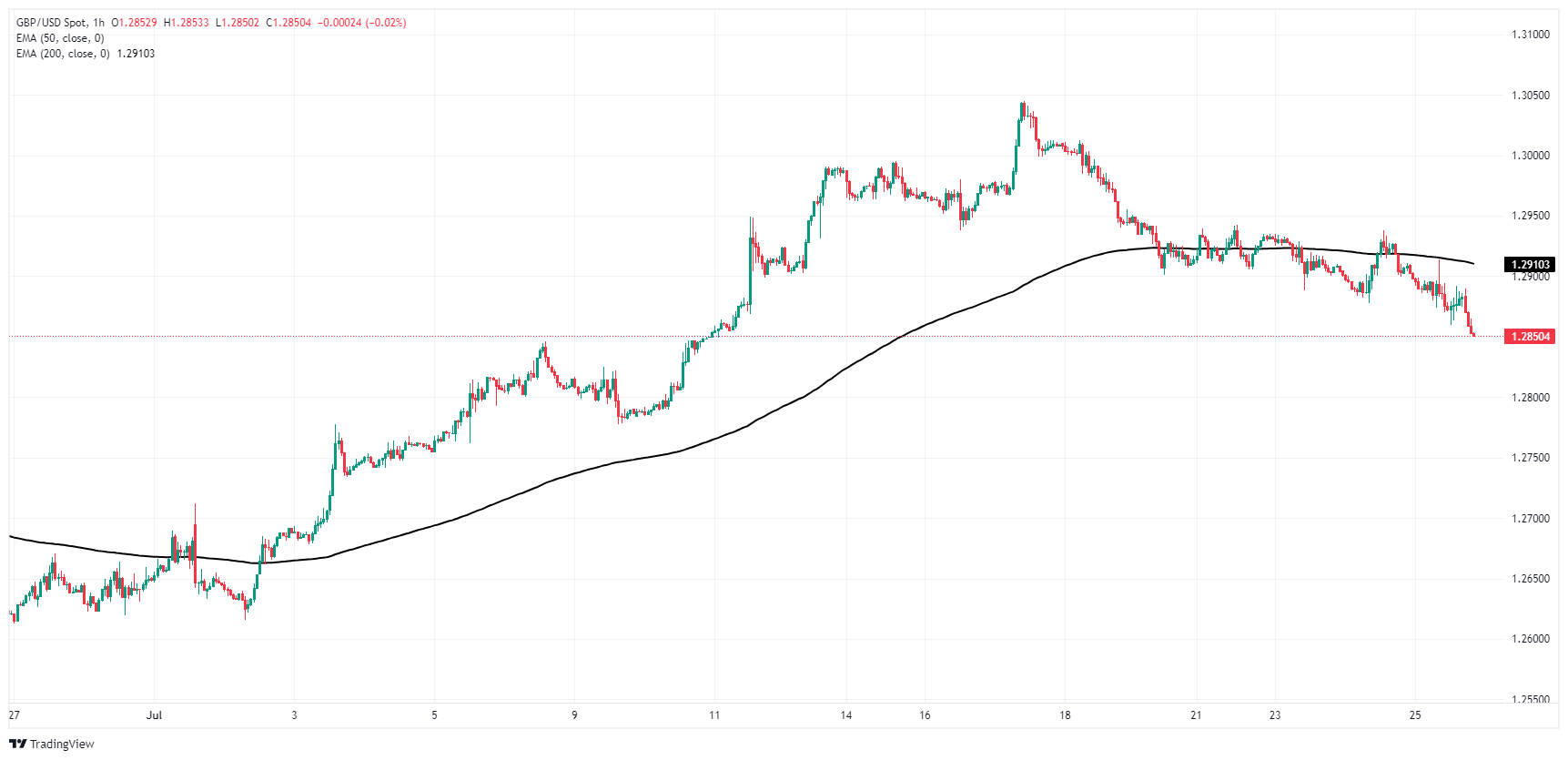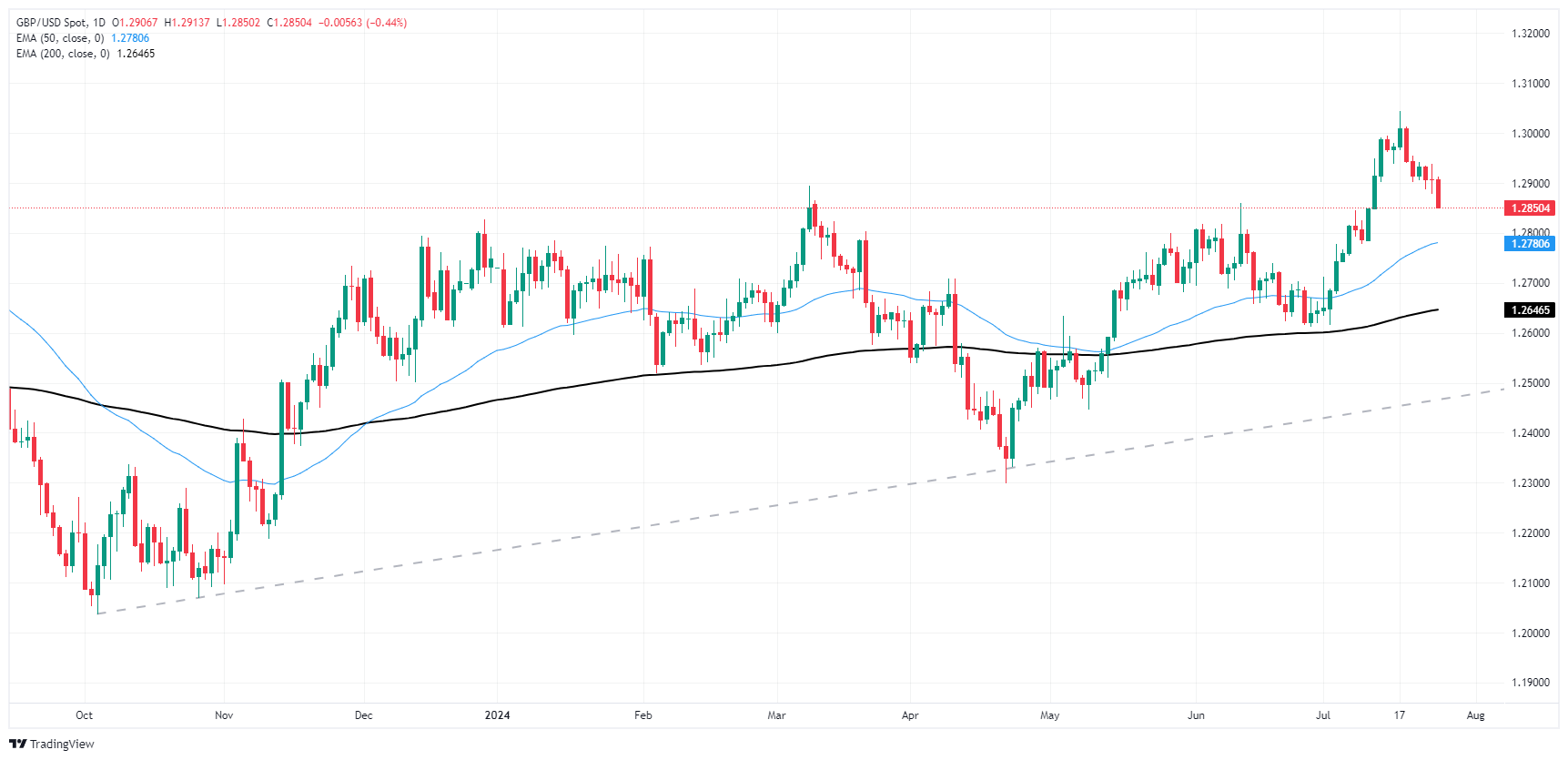- GBP/USD slid below 1.2860 on Thursday as GBP softens.
- Markets see roughly-even odds of a BoE rate cut.
- Lopsided US data bolstered the Greenback slightly, adding to Cable losses.
GBP/USD floundered on Thursday, chalking in a third straight trading day in the red and declining below 1.2860 as market expectations of a Bank of England (BoE) rate cut next week weigh down the Pound Sterling.
Forex Today: Can US PCE confirm a rate cut in September?
US Gross Domestic Product (GDP) lurched higher in the second quarter, bringing annualized Q2 growth to 2.8%, well above the forecast 2.0% and piling onto the first quarter’s 1.4%. Markets initially recoiled from the firm upswing in growth figures, but a sharp contraction in US Durable Goods Orders helped keep hopes pinned for softening data to help push the Federal Reserve (Fed) toward a September rate cut.
US Personal Consumption Expenditures Price Index (PCE) inflation is in the barrel for Friday, and median market forecasts expect a downtick to 2.5% in core PCE inflation for the year ended in June compared to the previous period’s 2.6%.
A one-two punch of central bank action is on the books for next week, with the Fed’s July rate call slated for Wednesday and the BoE’s own rate decision on Thursday. The Fed is still broadly expected to keep rates pinned for one more meeting, but markets are seeing roughly even odds of a quarter-point rate cut from the BoE. Money markets see the BoE’s benchmark rate getting trimmed to 5.0% from 5.25%, and expectations of a widening of the GBP’s rate differential is putting downward pressure on the Pound Sterling.
British Pound PRICE Today
The table below shows the percentage change of British Pound (GBP) against listed major currencies today. British Pound was the strongest against the New Zealand Dollar.
| USD | EUR | GBP | JPY | CAD | AUD | NZD | CHF | |
|---|---|---|---|---|---|---|---|---|
| USD | -0.05% | 0.44% | -0.02% | 0.14% | 0.69% | 0.74% | -0.47% | |
| EUR | 0.05% | 0.48% | 0.02% | 0.19% | 0.74% | 0.77% | -0.43% | |
| GBP | -0.44% | -0.48% | -0.45% | -0.30% | 0.27% | 0.29% | -0.91% | |
| JPY | 0.02% | -0.02% | 0.45% | 0.17% | 0.70% | 0.74% | -0.46% | |
| CAD | -0.14% | -0.19% | 0.30% | -0.17% | 0.55% | 0.59% | -0.62% | |
| AUD | -0.69% | -0.74% | -0.27% | -0.70% | -0.55% | 0.06% | -1.16% | |
| NZD | -0.74% | -0.77% | -0.29% | -0.74% | -0.59% | -0.06% | -1.21% | |
| CHF | 0.47% | 0.43% | 0.91% | 0.46% | 0.62% | 1.16% | 1.21% |
The heat map shows percentage changes of major currencies against each other. The base currency is picked from the left column, while the quote currency is picked from the top row. For example, if you pick the British Pound from the left column and move along the horizontal line to the US Dollar, the percentage change displayed in the box will represent GBP (base)/USD (quote).
GBP/USD technical outlook
Cable has declined -1.5% and counting from last week’s 52-week peak near 1.3045, and the pair is on pace to close in the red for five of the last six straight trading days. Intraday trading has turned firmly bearish as GBP/USD drops away from the 200-hour Exponential Moving Average (EMA) at 1.2910.
Despite a near-term pullback, the Cable is still trading deep into bull country, holding chart territory well north of the 200-day EMA at 1.2638. However, a sustained pullback could see the pair fall into a deep rising trendline drawn from last October’s lows near 1.2040.
GBP/USD hourly chart
GBP/USD daily chart
Pound Sterling FAQs
The Pound Sterling (GBP) is the oldest currency in the world (886 AD) and the official currency of the United Kingdom. It is the fourth most traded unit for foreign exchange (FX) in the world, accounting for 12% of all transactions, averaging $630 billion a day, according to 2022 data. Its key trading pairs are GBP/USD, aka ‘Cable’, which accounts for 11% of FX, GBP/JPY, or the ‘Dragon’ as it is known by traders (3%), and EUR/GBP (2%). The Pound Sterling is issued by the Bank of England (BoE).
The single most important factor influencing the value of the Pound Sterling is monetary policy decided by the Bank of England. The BoE bases its decisions on whether it has achieved its primary goal of “price stability” – a steady inflation rate of around 2%. Its primary tool for achieving this is the adjustment of interest rates. When inflation is too high, the BoE will try to rein it in by raising interest rates, making it more expensive for people and businesses to access credit. This is generally positive for GBP, as higher interest rates make the UK a more attractive place for global investors to park their money. When inflation falls too low it is a sign economic growth is slowing. In this scenario, the BoE will consider lowering interest rates to cheapen credit so businesses will borrow more to invest in growth-generating projects.
Data releases gauge the health of the economy and can impact the value of the Pound Sterling. Indicators such as GDP, Manufacturing and Services PMIs, and employment can all influence the direction of the GBP. A strong economy is good for Sterling. Not only does it attract more foreign investment but it may encourage the BoE to put up interest rates, which will directly strengthen GBP. Otherwise, if economic data is weak, the Pound Sterling is likely to fall.
Another significant data release for the Pound Sterling is the Trade Balance. This indicator measures the difference between what a country earns from its exports and what it spends on imports over a given period. If a country produces highly sought-after exports, its currency will benefit purely from the extra demand created from foreign buyers seeking to purchase these goods. Therefore, a positive net Trade Balance strengthens a currency and vice versa for a negative balance.
Information on these pages contains forward-looking statements that involve risks and uncertainties. Markets and instruments profiled on this page are for informational purposes only and should not in any way come across as a recommendation to buy or sell in these assets. You should do your own thorough research before making any investment decisions. FXStreet does not in any way guarantee that this information is free from mistakes, errors, or material misstatements. It also does not guarantee that this information is of a timely nature. Investing in Open Markets involves a great deal of risk, including the loss of all or a portion of your investment, as well as emotional distress. All risks, losses and costs associated with investing, including total loss of principal, are your responsibility. The views and opinions expressed in this article are those of the authors and do not necessarily reflect the official policy or position of FXStreet nor its advertisers. The author will not be held responsible for information that is found at the end of links posted on this page.
If not otherwise explicitly mentioned in the body of the article, at the time of writing, the author has no position in any stock mentioned in this article and no business relationship with any company mentioned. The author has not received compensation for writing this article, other than from FXStreet.
FXStreet and the author do not provide personalized recommendations. The author makes no representations as to the accuracy, completeness, or suitability of this information. FXStreet and the author will not be liable for any errors, omissions or any losses, injuries or damages arising from this information and its display or use. Errors and omissions excepted.
The author and FXStreet are not registered investment advisors and nothing in this article is intended to be investment advice.
Recommended content
Editors’ Picks
USD/JPY holds losses near 153.50 after Tokyo inflation data

USD/JPY is licking its wounds at around 153.50 after reversing sharply from 154.00 in early Asian trading. The pair came under renewed selling pressure after Tokyo's core inflation continued to rise in July, backing the case for a BoJ rate hike next week.
AUD/USD steadies near 0.6650, as markets turn cautious ahead of US PCE

AUD/USD sellers take a breather near 0.6650, refraining from placing fresh bets ahead of the US PCE inflation data. Continual weakness in China's economy paired with depreciating iron ore prices remains a major contributor to the recent decline in the Aussie.
Gold price finds support above $2,350, traders eye PCE data

Gold price is holding its modest recovery above $2,350 in early Asia on Friday. Gold price tumbled to a two-week low on Thursday after the US economy fared better than expected in Q2 2024, raising doubts on the scope of the Fed rate cuts this year. US PCE inflation awaited.
Celebrity meme coins lose their shine

Celebrity meme coins report by Jupiter Slorg on Thursday shows that these tokens have been in deep waters since early July after experiencing heavy growth in June.
Will financial markets get some relief as the week closes out?

There’s been no let-up in global growth worries this week and risk off price action has intensified as best reflected through more weakness in US equities. The latest concerns come from discouraging US earnings, ineffective China monetary policy easing efforts, and distressing data out of the Eurozone and UK.